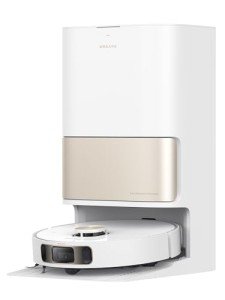The Evolution of Robot Hoovers: Revolutionizing Home Cleaning
Robot hoovers, also called robotic vacuum cleaners, have changed how individuals approach family cleaning tasks. At first presented in the late 1990s, these autonomous machines have developed quickly due to improvements in technology, artificial intelligence, and maker knowing. Today, they are equipped with a selection of features that make them highly reliable in maintaining tidiness in living areas. This post checks out the history, functioning, advantages, and future of robot hoovers.
The History of Robot Hoovers
The principle of robotic vacuums dates back to the 1970s, however it wasn't until the launch of the Roomba by iRobot in 2002 that they got mainstream attention. The Roomba was developed to instantly navigate different surface areas, preventing obstacles while effectively cleaning floorings. Given that then, a number of substantial developments have actually happened, including:
| Year | Development |
|---|---|
| 1996 | First prototype robotic vacuum developed by a Japanese business. |
| 2002 | iRobot launches the Roomba, mass popularizing robotic vacuums. |
| 2004 | Intro of the very first Roomba with a dirt detection sensor. |
| 2011 | Release of designs with wireless capabilities and smartphone integration. |
| 2020 | Advanced designs including AI, improved navigation systems, and mopping abilities. |
How Robot Hoovers Work
Robot hoovers operate on a mix of sensors, cameras, and algorithms that enable them to clean efficiently. Key components of these gadgets include:
Sensors:
- Obstacle Avoidance Sensors: Detect walls, furnishings, and even stairs, preventing crashes and falls.
- Dirt Detection Sensors: Identify locations that require more thorough cleaning.
Navigation:
- Gyroscopes: Help figure out the robot's orientation and motion.
- Cameras and Lidar: Enable mapping of the home environment to produce optimal cleaning courses.
Cleaning Mechanisms:
- Vacuum Motors: Generate suction to get dirt and debris.
- Brush Rollers: Agitate dirt out of carpets for much deeper cleaning.
Power Supply:
- Batteries: Rechargeable lithium-ion batteries provide the necessary power for extended cleaning cycles.
User Interface:
- Mobile Apps and Smart Home Integration: Users can arrange cleansings, display performance, and manage the robot remotely.
Benefits of Robot Hoovers
Robot hoovers provide many benefits, making them an enticing option for contemporary homes:
- Time-Saving: Automated cleaning permits users to focus on other jobs while the robot effectively cleans up floors.
- Convenience: Many designs can be arranged for cleaning sessions, making sure that homes remain neat without manual effort.
- Accessibility: Ideal for people with movement challenges or busy lifestyles, making it possible for easier home upkeep.
- Constant Cleaning: Regular, automated cleanings reduce the accumulation of dirt and allergens, contributing to a much healthier living environment.
- Smart Technology: Integration with smart home systems enables increased control and customization.
Limitations of Robot Hoovers
In spite of their advantages, robot hoovers feature certain constraints:
- Navigation Challenges: They may have a hard time in cluttered areas or with specific floor types such as high-pile carpets.
- Battery Life: Most models require routine charging, which can limit cleaning duration.
- Upkeep: Regular cleaning of filters, brushes, and clearing dust bins is needed for optimal efficiency.
- Price: Advanced models can be pricey compared to conventional vacuum cleaners.
The Future of Robot Hoovers
As innovation continues to evolve, the future of robot hoovers looks appealing. Expected developments consist of:
- Improved AI: Enhanced algorithms will enable better things acknowledgment and vibrant mapping of areas.
- Hybrid Models: Integration of vacuuming and mopping capabilities in one device will supply an extensive cleaning option.
- Increased Autonomy: Future designs may browse even the most intricate environments without human intervention.
- Sustainability: Battery innovation advancements will result in longer-lasting, more energy-efficient robots.
Regularly Asked Questions (FAQs)
1. Are robot best robot vacuum under 200 for pet hair elimination?
Yes, numerous robot hoovers are particularly designed to take on family pet hair with effective suction and specialized brushes that decrease tangling.
2. How do robot hoovers browse around furnishings?
Robot hoovers utilize a combination of sensors and cameras to discover obstacles, permitting them to navigate around furnishings and prevent crashes.
3. best robot vacuum for large house hoovers clean carpets?
A lot of modern robot hoovers work on both difficult floorings and carpets. It is advisable to check the requirements of specific models for specific efficiency.
4. Do robot hoovers require programs?
Many robot hoovers feature user-friendly apps that enable owners to set schedules and personalize cleaning preferences, making shows uncomplicated.
5. How much do robot hoovers cost?
Costs for robot hoovers vary commonly, ranging from ₤ 200 to around ₤ 1,500, depending upon functions and brand name.
Robot hoovers have actually come a long way considering that their beginning, providing an efficient and convenient cleaning service for contemporary households. Their increasing ability and intelligence make them a useful choice for individuals wanting to streamline their cleaning regimens. As technology continues to advance, robot hoovers will likely become even more capable, offering extra features that deal with the evolving needs of users. Their journey from novelty to need underscores a basic shift in how society approaches home upkeep, marking a substantial turning point in the crossway of technology and life.

